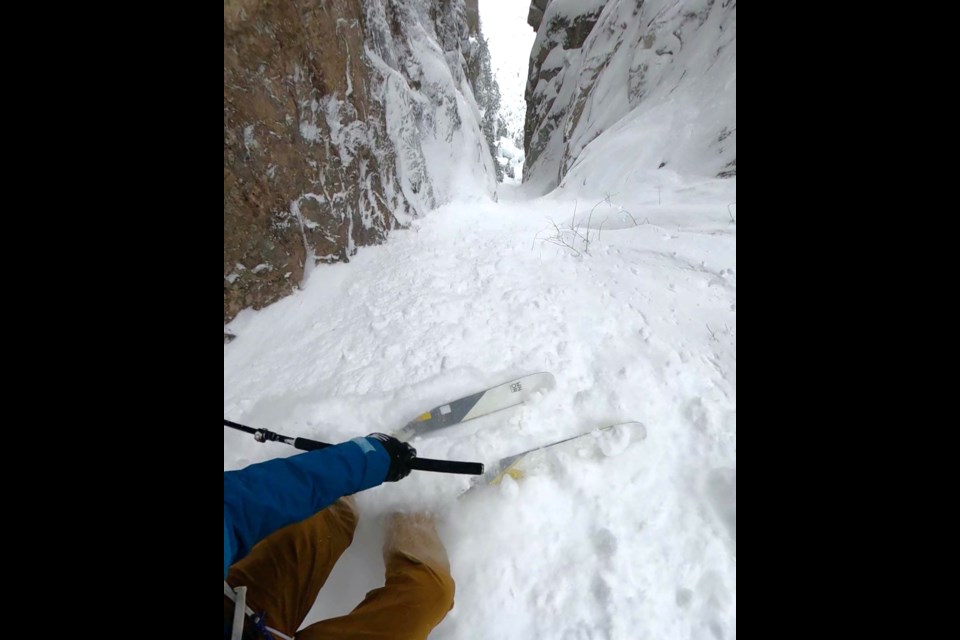It is not every day you can ski the Siám' Smánit (Stawamus Chief) before work, but that is just what Paul Greenwood and his friends did last week.
While there may have been others who skied the North Gully under the radar or back in the day, it is the first descent that Greenwood and fellow skiers Eric Carter and Chris Christie know of. (The South Gully has been reportedly skied by Jean-Francois Plouffe.)
Like many local winter adventurers, the trio had long looked up at the Chief and wondered if they could ever ski it.
Then came the early January big dump of snow, followed by more snow.
The experienced rock climbers, skiers and mountaineers went from the top of Second Peak and were able to ski into the gully — between the rock slabs of the Chief — with a couple of rappels as they worked their way down.
Inside the couloir, Greenwood, 34, said the cool factor of what they were doing set in.
"You're in and you're looking up. There are big walls on either side. You're like, 'Whoa, man, where am I? This is so cool... Where are we?’ This is insane,' because usually we're climbing up on the ridges, looking down into this and now we're like looking up at where we'd be normally be climbing. So it was quite amazing," he said, adding the views of Valleycliffe, the Smoke Bluffs, Atwell and Nch'kay [Mount Garibaldi] were second-to-none.
"It was pretty unreal. Like, before we even dropped in, you're looking at Howe Sound and you have your skis on. That's pretty cool."
How they did it
To ski the gully, required hiking, skinning, boot packing and rock climbing, in addition to regular skiing.
The men hiked up the backside trail, which was a little icy, as it usually is in winter, to the Second Peak.
"We were skinning from pretty low, because there's a lot of snow... And then we had to boot pack a little bit, and it's quite deep to get to the top of Second Peak. And then, once we were on top, at Second Peak, we were able to rip our skins and ski down from the top of the Second Peak to the gully, which is in between Second and Third peak," said Greenwood, a local chiropractor who is a former ski racer and racing coach.
Skinning involves attaching nylon strips to the bottom of skis, and boot packing is literally travelling on your ski boots.
At the start of the gully, they found bushes and rock.
"So we found a tree, put a rope around it, and we attached belay devices, and then you lower yourself on the rope, which is rappelling," he explained.
The three could ski a bit from there and then reached another patch of rock that they had to rappel over.
Safety
The three adventurers have plenty of experience and training in the backcountry, including avalanche training, and they considered their risks.
"We had some climbing gear with us. We had ropes, we had harnesses. We were really racked up for battle. We had ice axes, crampons. But we didn't need a lot of that kind of stuff. But we were ready in case stuff went sideways," Greenwood said.
They were a bit concerned about things falling from the walls of the gully they were skiing through.
"We didn't want ice to fall on us. We didn't want any avalanches to fall down on us from the upper walls. But because they're quite vertical, we were thinking...it's probably shed off the walls of the gully and gone into the couloir proper, which will make it a lot more snow to ski. And that was totally what happened," Greenwood said. "We were actually getting pretty good powder turns, which was pretty awesome."
The whole thing took about five or six hours. They all had work commitments and so had to be done by early afternoon, said Greenwood.
"I did push a couple of patients back, and I had their numbers, so I messaged them, ‘Adventuring a little hard, right now, I might be a little late,'" he recalled, noting his patients are used to the adventures he gets up to before work.
Since the feat, Greenwood said plenty of folks have reached out to the locals to ask how they accomplished it.
The next day someone repeated it.
"Which is really cool," Greenwood said, adding that since then, the weather has deteriorated, leading to worsening conditions.
"It's probably not the best idea to be in there [now]," he said.
The bigger picture
As cool as it was to ski the Chief, the reason it could be done can't be ignored, Greenwood said.
"When we were skiing out of it, you ski through where all that rockfall was [in] the summer. And it's really interesting to kind of reflect on just the major extremes of weather we've had. The fact that it was so hot there this summer that the rock was being challenged in such a way that it was failing and having these huge landslides, essentially. And then we're at the other extreme, where it's so cold that we're getting enough snow at sea level that we're able to ski — like put turns into this area. So it was kind of bittersweet in the fact that it's super exciting that we've done this, but it's really highlighting the, you know, climate change and how these extremes are playing into how we interact with this space," he said.
"What we did was super fun. It was a really cool novelty. But it's really just highlighting these changes and these extremes in the weather that we wouldn't really normally get here."




